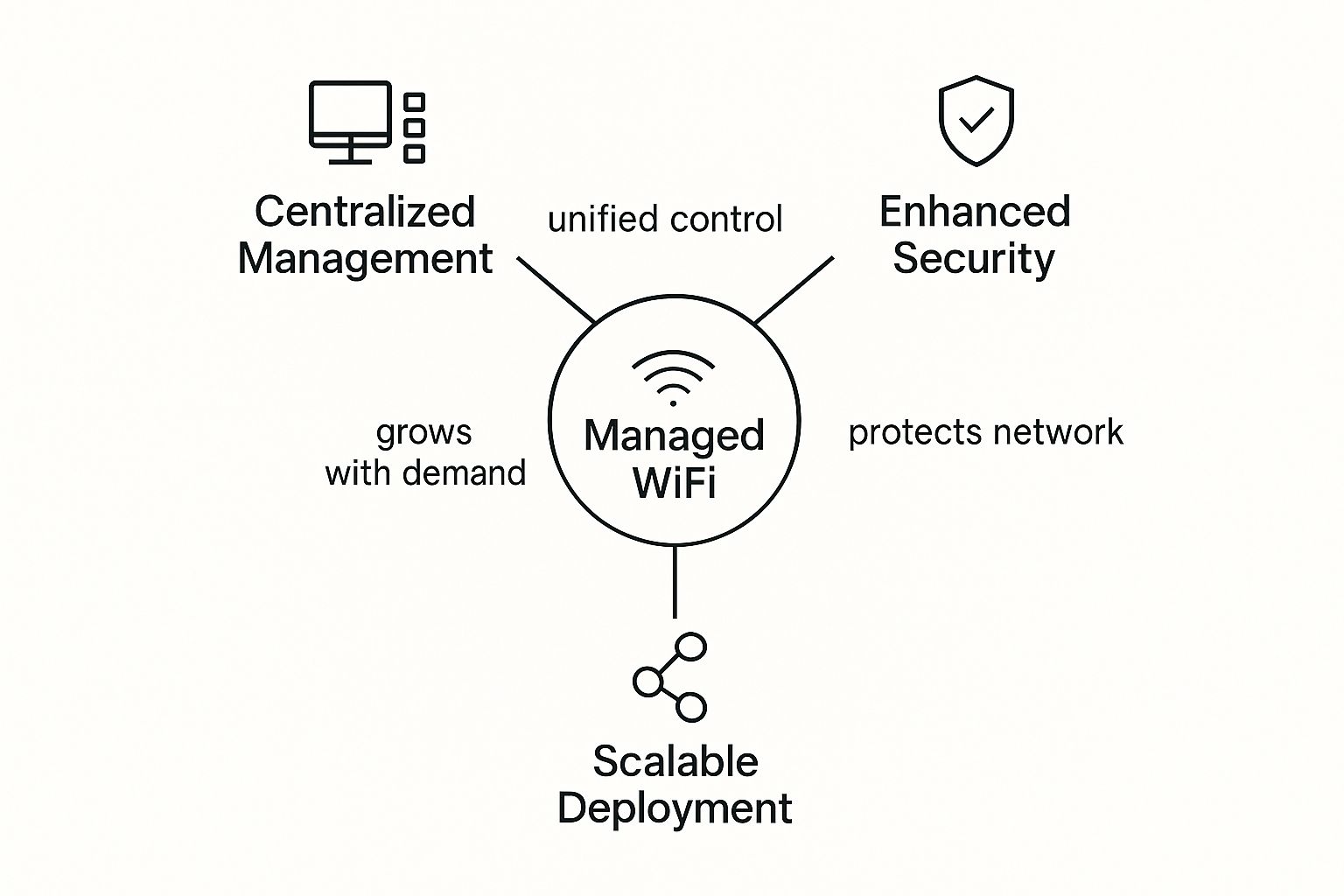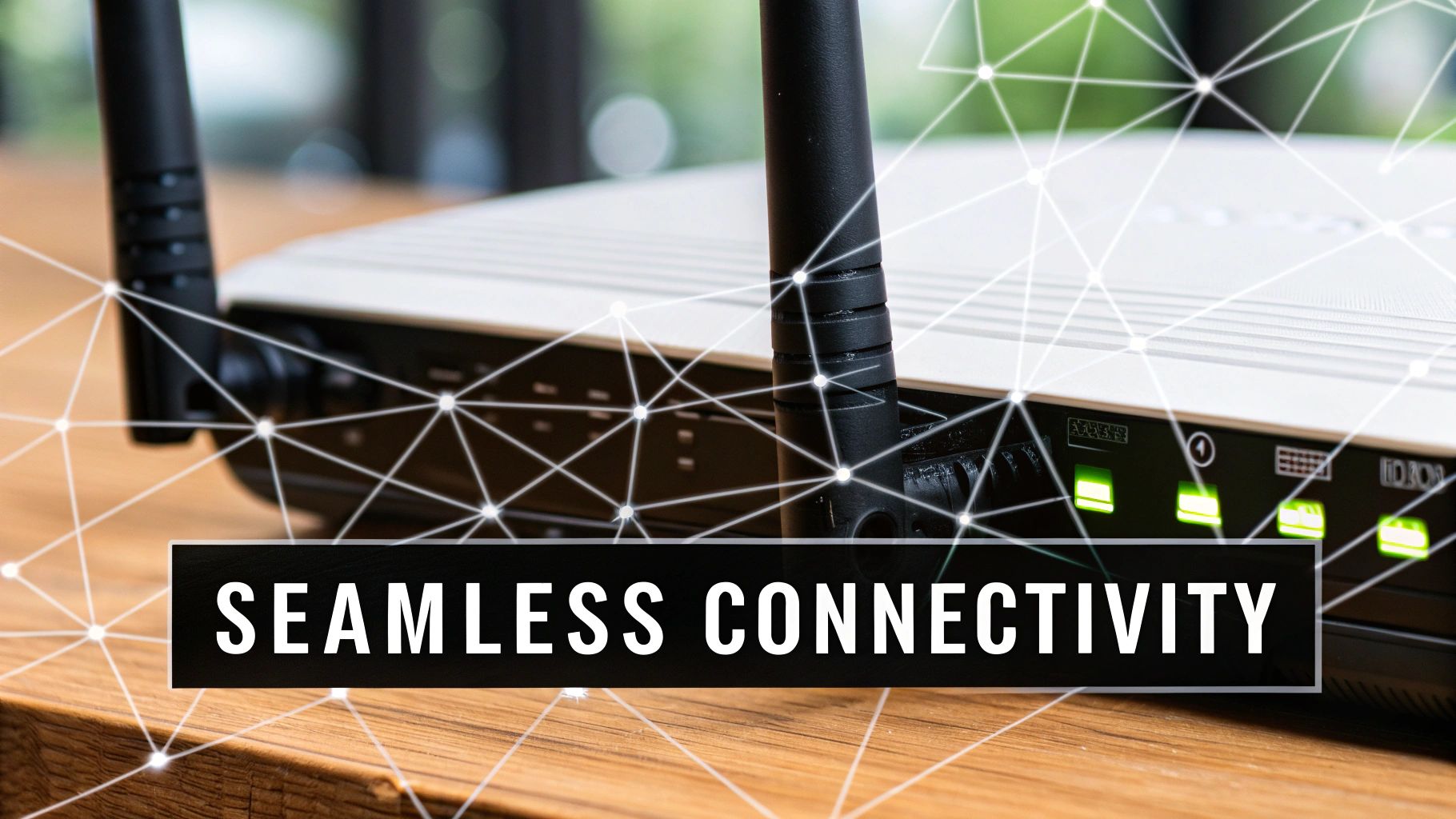In simple terms, Managed Wi-Fi is a service where a third-party expert designs, installs, monitors, and maintains your entire business Wi-Fi network for you. It essentially turns a complex technical headache into a reliable, subscription-based utility.
From DIY Headaches to Hands-Off Reliability
Think about your current business Wi-Fi. If you’re managing it yourself, you’re not just using the network—you’re the on-call mechanic. Every firmware update, security patch, and unexpected outage falls on your shoulders. This DIY approach forces you to spend precious time troubleshooting dead zones, dealing with slow speeds, and constantly worrying about security threats.
Managed Wi-Fi completely flips that script. It’s more like an all-inclusive car lease where you just get in and drive. The provider handles all the complex maintenance behind the scenes. This hands-off model ensures your team, customers, and business systems always have the fast, secure, and dependable connection they need. You get to focus on what you do best: running your business, not your network.
The real value here is offloading the entire lifecycle of your Wi-Fi network to specialists who live and breathe this stuff. You get enterprise-grade performance without needing an in-house IT army to deliver it.
Managed WiFi vs Traditional WiFi at a Glance
To make the distinction crystal clear, it helps to see the two approaches side-by-side. The table below breaks down the key differences between a fully managed service and a traditional, do-it-yourself setup.
| Aspect | Managed WiFi | Traditional WiFi |
|---|---|---|
| Setup & Installation | Handled by expert technicians | DIY or hired on a one-time basis |
| Monitoring & Maintenance | Proactive, 24/7 monitoring by the provider | Reactive; you fix problems as they arise |
| Security | Enterprise-grade, continuously updated | Your responsibility to configure and update |
| Support | Dedicated expert support included | Self-service or paid third-party help |
| Hardware | Included and refreshed as part of the service | Purchased and owned outright by you |
| Scalability | Easily scalable with provider assistance | Requires manual upgrades and new hardware |
| Cost Structure | Predictable monthly subscription (OpEx) | Large upfront investment (CapEx) |
As you can see, the choice comes down to whether you want to own and operate a technical asset or simply subscribe to a reliable outcome.
A Rapidly Growing Market
This move away from DIY isn’t a small trend; it’s a major market shift. The global managed Wi-Fi market ballooned from $4.2 billion in 2022 and is projected to hit $9.1 billion by 2027, growing at a compound annual rate of 17.3%. This explosive growth was kicked into high gear by the universal demand for rock-solid, secure connectivity in every industry. You can dig into more [data on this market growth](https://www.marketsandmarkets.com/Market-Reports/managed-wi-fi-solutions-market-2Managed Wi-Fi vs Traditional WiFi at a Glance1754593.html) from recent industry analyses.
The image below shows how the core pillars of managed Wi-Fi—centralized management, robust security, and easy scalability—all work together.

This integrated approach is exactly why so many businesses are making the switch. Instead of trying to piece together solutions from different hardware, security, and support vendors, you get a single, accountable partner whose only job is to keep you connected. It’s about trading a reactive, break-fix mentality for a proactive, performance-first strategy.
The Core Components of Your Managed Wi-Fi Service

When you sign up for a managed Wi-Fi service, you’re not just getting a faster internet connection. You’re bringing in a team of specialists with the hardware, software, and expertise to deliver something much more valuable: hassle-free, dependable connectivity that just works.
Let’s pull back the curtain and look at what this kind of service actually includes. These are the core pieces that work together to turn your Wi-Fi from a frustrating chore into a reliable tool for your business.
Expert Network Design and Installation
A great Wi-Fi network doesn’t happen by accident; it starts with a smart plan. Before any equipment is unboxed, a good managed provider conducts a professional site survey. Think of it as creating a detailed blueprint of your workspace. They’ll analyze your floor plan, identify sources of interference, and pinpoint physical barriers like concrete walls or metal shelving that can kill a Wi-Fi signal.
The entire point is to get rid of dead zones and guarantee a strong, stable connection everywhere you need it, whether that’s at the front reception desk or deep in the warehouse. This survey leads to a custom network design that strategically places high-quality, commercial-grade access points for the best possible performance.
With the plan in place, experienced technicians take over for the installation. This is far more involved than just plugging in a router from a big-box store. It includes:
- Strategic Hardware Placement: Carefully mounting access points, switches, and other gear exactly where the site survey determined they’ll be most effective.
- Professional Cabling: Running and hiding all the necessary data cables for a clean, professional look that’s also safe and reliable.
- System Configuration: Dialing in all the settings for robust security, seamless guest access, and peak performance based on how you actually use your network.
This hands-on, professional approach makes sure your system is optimized right out of the gate, avoiding all those frustrating slowdowns and connection drops that often come with a DIY setup.
A managed service takes the guesswork completely out of the equation. Instead of plugging in access points and just hoping for the best, the provider uses specialized tools to build a network that’s guaranteed to handle your specific coverage and capacity needs.
Proactive Monitoring and 24/7 Support
Once your new network is up and running, the provider’s job isn’t done—in many ways, it’s just getting started. A huge part of any managed Wi-Fi service is proactive 24/7 network monitoring. Behind the scenes, sophisticated software and a dedicated Network Operations Center (NOC) are keeping a constant eye on your system’s health.
They’re tracking performance, watching for security threats, and can often spot and fix a problem before you or your staff even realize anything is wrong. If an access point suddenly drops offline or performance starts to lag, their system flags it instantly, and technicians get to work. This is a world away from the old “break-fix” routine, where you only call for help after a problem has already caused a major headache.
And when you do need help, you get a direct line to experts who know your system intimately. No more wasting hours on hold with a generic call center, re-explaining your setup every single time. You talk to people who can pull up your network’s status and get right to solving the problem, which means you get back to business much faster.
Strategic Business Benefits of Managed Wi-Fi

It’s one thing to understand the technical nuts and bolts of managed Wi-Fi, but the real question every business owner asks is simple: “What’s in it for me?” The answer isn’t just about better internet; it’s about gaining clear, strategic advantages that strengthen your operations, security, and bottom line. It’s about turning a basic utility into a real competitive edge.
A huge win right off the bat is enhanced security. Let’s face it, in a world full of cyber threats, a standard, off-the-shelf network can be a serious weak spot. Managed Wi-Fi providers bake robust security right into the service. This includes things like secure guest networks to keep visitor traffic safely separate from your own, plus advanced threat detection that’s always on the lookout for suspicious activity. This professional-grade security is crucial for protecting your sensitive business data and your customers’ trust.
Boosting Performance and Predictability
Beyond keeping the bad guys out, performance is everything. We’ve all been there—slow speeds and dropped connections are more than just annoying. They can bring essential tools, like your point-of-sale (POS) systems or video conferencing software, to a screeching halt. Managed services deliver high performance and reliability, backed by a formal Service Level Agreement (SLA) that contractually guarantees uptime and sets clear expectations for support.
This approach also brings a welcome dose of predictability to your budget. Instead of getting hit with sudden, large expenses for hardware upgrades or emergency repairs, managed Wi-Fi turns your network costs into a stable, monthly operating expense. This model doesn’t just simplify budgeting; it can also help businesses reduce operational costs by cutting down on IT overhead and making the network more efficient.
By outsourcing your network management, you’re not just buying Wi-Fi; you’re investing in guaranteed uptime and business continuity. This frees you up to focus on growing your business instead of constantly putting out IT fires.
Seamless Scalability and Future-Proofing
Your business is built to grow, and your network needs to be able to keep up. Whether you’re expanding to another floor, opening a new location, or simply connecting more devices, a managed network scales right alongside you. Your provider handles all the heavy lifting, ensuring new areas get the same high-quality coverage without the headache and expense of a complete network overhaul.
This forward-thinking approach is more important than ever. The demand for these services is skyrocketing for good reason. Projections show the managed Wi-Fi market is on track to expand at a compound annual growth rate of 9.8% between 2025 and 2033, climbing to an estimated size of over $7.42 billion. This boom is driven by the explosion of IoT devices and the growing need for centralized, cloud-based network control.
At the end of the day, opting for managed Wi-Fi is a strategic move that delivers far more than just a connection. If you’re interested in exploring how these solutions can be customized for your specific needs, take a look at our complete overview of https://clouddle.com/blog/managed-wifi-services/. It’s a smart way to build a foundation for better security, scalable growth, and operational peace of mind.
How Different Industries Use Managed Wi-Fi
The real power of managed Wi-Fi snaps into focus when you look at how it solves everyday problems in different industries. It’s not just a generic service; it’s a flexible tool that adapts to the specific demands of a business, whether that’s keeping guests happy or protecting sensitive data.
Seeing these real-world examples helps move beyond the technical jargon. You start to see managed Wi-Fi for what it truly is: a foundational service that supports a company’s most important functions.
Hospitality and Guest Experience
In any hotel today, a spotty internet connection is a deal-breaker. Great Wi-Fi isn’t a bonus amenity anymore; it’s a core expectation. Managed Wi-Fi provides the reliable backbone guests need for everything from streaming their favorite shows to jumping on a last-minute video call. Hotels can even set up different access levels, offering a solid free connection for everyone and a premium, high-speed option for those who need more bandwidth.
Even more critically, the service keeps guest traffic completely separate from the hotel’s internal network. This separation is key to protecting essential systems like booking software, payment processing, and staff communications, ensuring they run without a hitch. If you’re curious about the specifics, you can check out some of the top WiFi solutions for hotels and see how they’re designed.
In a crowded market, a hotel’s digital experience is just as important as its physical one. Managed Wi-Fi makes sure that experience is fast, secure, and completely seamless from the moment a guest checks in.
Retail and Smart Operations
For a retailer, a reliable connection is tied directly to the bottom line. Managed Wi-Fi is what keeps modern point-of-sale (POS) systems running smoothly, making sure transactions are quick and dependable, especially during busy shopping seasons. A network crash during a holiday rush can mean thousands in lost sales and a crowd of unhappy customers.
Beyond that, a guest Wi-Fi network can be a surprisingly powerful marketing tool. By offering free access in exchange for something as simple as an email, retailers can:
- Build valuable customer lists for future email campaigns and promotions.
- Collect anonymous data on in-store traffic and see where shoppers spend the most time.
- Send targeted discounts and offers directly to a shopper’s phone while they are in the store.
Healthcare and Corporate Environments
The stakes are incredibly high in healthcare. A managed network is the lifeline that connects critical medical devices, secures electronic health record (EHR) systems, and enables clear communication between doctors and nurses. It provides the heavy-duty security and network segmentation needed to protect patient data under strict HIPAA regulations, all while giving patients and their families simple, reliable internet access.
In the corporate world, the challenge is different but just as complex. An office has to support hundreds or even thousands of devices at once, from employee laptops to the IoT sensors that run a smart building. A managed Wi-Fi service is built to handle this high-density environment, delivering the rock-solid performance that keeps everyone productive.
How to Choose the Right Managed WiFi Provider

Picking a managed Wi-Fi provider is a lot like choosing a long-term business partner. Get it right, and your operations will run smoothly. Get it wrong, and you’re in for a world of headaches. Not all providers are created equal, so you have to do your homework.
Your first stop should be their Service Level Agreement (SLA). This isn’t just a formality; it’s the contract that spells out their commitments in black and white. You’re looking for concrete, measurable guarantees, not fuzzy promises.
What should a solid SLA have?
- Guaranteed Uptime: A firm commitment to network availability, usually 99.9% or even higher.
- Response Times: Specific timelines for how quickly they’ll acknowledge and fix problems.
- Performance Metrics: Hard numbers on what to expect for network speed and latency.
Think of the SLA as your primary tool for accountability. If a potential provider is cagey about sharing a detailed one, that’s a serious red flag.
Digging into Security and Compliance
Security is a massive reason businesses switch to managed Wi-Fi, so you need to look closely at their security measures. Ask them about their threat detection systems, what they offer for content filtering, and how they isolate and protect guest networks. This is especially critical if you’re in a regulated field like healthcare or finance, where you need a provider who understands compliance for standards like HIPAA or PCI DSS.
A provider’s security mindset should be proactive, not just reactive. They need to be hunting for threats 24/7, not just cleaning up the mess after a breach. It’s this constant vigilance that keeps your business and your customers’ data safe.
The managed Wi-Fi market is booming. It hit a global value of around $7.03 billion in 2024 and is expected to reach $16.86 billion by 2033. This explosive growth means a lot of new players are jumping in, making it more important than ever to check a provider’s credentials and experience in your industry. You can see the full breakdown in this market analysis from Business Research Insights.
Evaluating Support and Experience
Finally, take a hard look at their customer support and track record. When things go wrong, who are you actually calling? Is it a team of skilled technicians who know your system inside and out, or a generic call center reading from a script? You want 24/7 access to real experts.
Ask for case studies or references from businesses that look like yours—similar in size and industry. A provider that’s fantastic for a small coffee shop might not have the chops to handle a large corporate office. A big piece of this puzzle is making sure they can handle guest access properly. For a deeper dive into what that involves, check out our guide on how to set up guest Wi-Fi securely. A little extra research upfront will ensure you find a true partner who’s invested in your success.
Here is the rewritten section, designed to sound completely human-written and natural.
Is Managed WiFi the Future of Business Connectivity?
When you really get down to it, managed Wi-Fi is more than just another service you pay for. It represents a fundamental shift in how businesses handle their connectivity. By handing over the keys to your network management, you’re doing more than just lightening the load on your IT team; you’re gaining a real strategic advantage. It frees you up to pour your energy and resources back into what you do best—running your business and serving your customers—with the peace of mind that your digital infrastructure is rock-solid.
What’s truly exciting, though, is what’s on the horizon. We’re moving toward networks that are smarter and more autonomous than ever before.
The Rise of Intelligent Networks
The future of managed Wi-Fi is being pulled forward by two major forces:
- AI-Powered Optimization: We’re now seeing providers bake Artificial Intelligence directly into their services, creating networks that can essentially heal and optimize themselves. Imagine a system that anticipates problems before they happen, automatically sidesteps interference, and constantly tweaks performance—all without a technician ever needing to intervene.
- The IoT Ecosystem: The Internet of Things (IoT) is no longer a buzzword; it’s a reality. From the smart thermostats and lighting in an office to the critical connected equipment in a hospital, countless devices need a network they can depend on. A secure, high-performance managed Wi-Fi network is the backbone that makes this entire ecosystem of devices not just possible, but reliable.
This evolution changes the game entirely. Your network stops being a passive utility, like electricity or water, and becomes an intelligent, responsive asset that actively works for you. It’s not just about getting online anymore; it’s about building a platform for future growth and innovation.
Thinking about what is managed Wi-Fi in this context really reframes the whole discussion. It stops being an expense line on a budget and starts looking like what it truly is: a foundational investment in your company’s agility, security, and long-term success.
Your Questions About Managed Wi-Fi, Answered
Making a change to how you handle your business Wi-Fi naturally brings up some questions. It’s a big decision. Here, we’ll walk through the common concerns we hear from business owners, giving you the clear, straightforward answers you need to feel confident about your next steps.
Is Managed Wi-Fi More Expensive Than a Traditional Setup?
It’s easy to look at the recurring monthly fee and assume so, but many businesses find their total cost of ownership is actually lower. Think about a traditional setup: you face a massive upfront hardware bill. On top of that, you’re responsible for every unexpected repair, every replacement, and the very real (and very hidden) cost of downtime when things go wrong.
A managed Wi-Fi service flips that model on its head. It bundles everything into a single, predictable operating expense. This makes budgeting a breeze and often saves you money over the long haul by sidestepping expensive outages and the need to pay IT staff to babysit the network.
Can My Small Business Really Benefit From This?
Absolutely. In fact, small businesses are often the perfect fit for managed Wi-Fi precisely because they don’t have a big, dedicated IT department. Outsourcing your network to a provider is like getting an enterprise-level IT team, with all their expertise and high-end tools, without the enterprise-level price tag.
It’s a way to level the playing field. You can offer the same robust, reliable connectivity as your largest competitors, letting you pour your time and resources into what you do best—growing your business, not wrestling with tech problems.
Managed Wi-Fi gives small businesses a serious leg up by taking a complex technical headache off their plate. You get professional-grade service and security, a powerful asset when you’re up against bigger players.
How Long Does It Take to Get Set Up?
The timeline really depends on the size of your space and how complex the layout is. The great thing is, a professional provider handles the entire project from start to finish. It all begins with a detailed site survey where they map everything out and design a custom network before a single piece of equipment is installed.
This careful planning phase is what makes the actual deployment so smooth. The provider’s main goal is to get you up and running with minimal disruption to your business, often completing the full installation and switch-over from your old system in just a few days.
What Happens If My Business Grows?
This is where managed Wi-Fi truly shines. Scalability is built-in from day one. Any good provider will design your initial network with an eye toward the future. When it’s time to expand—whether that means adding coverage to a new floor, another building, or just a dead spot in the warehouse—the process is incredibly simple.
You just give your provider a call. They handle the rest. They’ll add and configure new access points, making sure the new zones have the same high-performance connection as everywhere else. Your network just grows right along with your business, without any growing pains.
Ready to stop worrying about your network and start focusing on your business? The team at Clouddle Inc specializes in designing, deploying, and managing high-performance Wi-Fi solutions that just work. Discover how our Network-as-a-Service can provide your business with a secure, scalable, and reliable connection with zero upfront costs. Explore our managed technology solutions and get a network built for your success.


